#post war architecture rhineland
Text

mauritiuswall // köln mauritiusviertel
time and again you come across hidden gems of modern architecture in cologne. it's worth wandering through the side streets and discovering them.
immer wieder stößt man in köln auf versteckte kleinode der modernen architektur egal welcher stilrichtung. es lohnt sich durch die nebenstraßen zu streifen und sie zu entdecken.
#brutalism#brutalismus#architecture#photography#architecture photography#design#cologne#köln#köln mauritiusviertel#nrw#rhineland#nachkriegsmoderne#nachkriegsmoderne köln#nachkriegsmoderne rheinland#nachkriegsmoderne deutschland#nachkriegsarchitektur#nachkriegsarchitektur köln#nachkriegsarchitektur deutschland#nachkriegsarchitektur rheinland#post war modern#post war architecture#post war architecture rhineland#post war modern rhineland#germany#post war achitecture cologne#post war modern cologne#post war modern germany#post war architecture germany#brutalismus germany
263 notes
·
View notes
Text
Top 8 Places to visit in Germany
Introduction
Germany is a beautiful country for tourism. The Rhine Gorge, Berlin, Munich, Frankfurt, and Hamburg are some of the most popular places to visit in Germany.
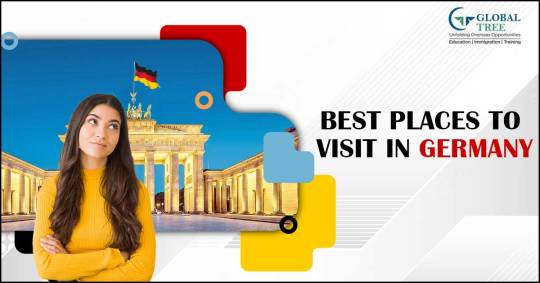
Germany is a beautiful country for tourism
• Germany is a beautiful country for tourism.
• There are many tourist places in Germany to visit.
• It's very safe for tourists to come here and enjoy their vacations, as there are no wars or terrorist attacks in the country.
• There are many attractions that tourists can go see when they come here, such as museums, castles, and palaces.
Rhine Gorge
The Rhine Gorge is a canyon formed by the River Rhine. It is located in the state of North Rhine-Westphalia, Germany, between Bingen and Bonn.
The Rhine Gorge forms part of one of Europe's largest UNESCO World Heritage Sites: Rhineland-Pfalz/Saarland with its regionally abundant cultural heritage and natural richness. Remember that one can get into the country if they only have Germany Visitor Visa.
Berlin
Berlin is the capital city of Germany and has a population of 3.35 million people. It's also the second most populous city in Germany, with a population density of 3,500 people per square kilometer. The first time I visited Berlin was when I was 13 years old, so it wasn't until recently that I got back there again as an adult and saw how much it had changed since my childhood memories.
Munich
Munich is the capital of Bavaria and one of the most important cities in Germany. With its rich cultural heritage, Munich is a city you should visit at least once in your life.The main tourist attractions include museums such as Deutsches Museum, Lenbachhaus and Alte Pinakothek; landmarks like Marienplatz Square and Hofbr�uhaus brewery; parks like Englischer Garten Park or Olympic Stadium Park; churches like Frauenkirche Cathedral or St Peter's Church (St Peterskirche). (Read More: Top 5 attractive things about Germany)
Frankfurt
Frankfurt is the largest city in the German state of Hesse and the fifth-largest city in Germany. It is known for its financial district, called Bankenviertel (Banking District), with many high-rise buildings such as Messeturm (Exhibition Tower), Westendstrae and Taunusanlage.
Hamburg
With 1.8 million residents, Hamburg is the second-largest city in Germany. It is also one of the most important ports in Europe and has been dubbed "the gateway to Europe".
The city's history dates back to its founding as a small trading post by Vikings more than 1,000 years ago. Hamburg later became part of the Hanseatic League (Hansa), an alliance between trading cities that controlled trade along sea routes from Scandinavia to Central Europe. (Read More: The easiest ways to immigrate to Germany)
Nuremberg
In the Middle Franconia administrative region of the German state of Bavaria, Nuremberg is a city. It is situated along the Rhine-Main-Danube Canal and the Pegnitz River. Nuremberg was one of the great European cities of the Middle Ages because of its importance in trade and commerce as well as its being an imperial city (Kaiserpfalz).
Dresden
Dresden is the capital of Saxony and one of Germany's most popular tourist destinations. The city has a lot of history, with its Baroque architecture being famous around the world. It's also home to many museums and galleries, which makes it a great place for history buffs to visit.
Cologne/Bonn
Cologne is the fourth largest city in Germany, with a population of over 1 million people. Travel to Cologne, Germany to witness the beauty of the Rhine River, which runs through the city center and divides it into two parts: Rheinauhafen (right bank) and Innenstadt (left bank).
Conclusion
Germany is a beautiful country for tourism. It has many places to visit, from Rhine Gorge to Berlin and Munich. If you are planning a trip to Germany, then make sure that you visit these eight cities as well.
0 notes
Photo

Painter SEAK Claus Winkler: dipped in to carneval. nuance compared to my 20s, teens/ childhood. pasta/ pizza (carbs). 3 glasses redwine. No beer ( Kölsch), calories, nasty hangoverish post day feeling. The street carnival trains belong to my childhood memories. Some liberated good vibes after all the reality cold showers the last year from our new poc migrants. Bringing deadly medieval blade violence back for here to stay. Forcing us german man, to man up, hold our heads up, addapt accordingly. Was although good seeing women with in a attractive appropriate age ( 18-24 years). Although lots of natural non tattooed (❤️👍) 8s,9s,10s, where lining up in sight, though below 18 years (legal age in Germany), a no. ☹️. In general, less costumes, less people, less native slang, less decorated Waggons 🙁. healthy for my psyche mingling, joining the good vibes. With all the toxic left woke nonsense, poc on caucasians/ native deadly violence & cultural/ genetic cucking it’s is necessary standing by your native culture ( in my case: german/ north european , Rhineland, austrian, english, eastprussian/ pommerian) supporting, loving, living it. In German i would have written this different. language = vibe. A shame i speak so less cologne slang ( Kölsch/ rheinisch/ buure platt ( Farmer/ Rural suburbian Slang).the industrial Rhineland ugly. Industry investment architecture + late war allied carpet bombing leveling out anything architectural beautiful with culture identity. Carnival, with the 1000 year tradition, a way to comprehend that reality. a stepping stone, which inspired me being creative, being a painter. My first carnival expierences are where my studio is. Carnival was although always good seeing attractive females with in my teens. ( like profiles/ insta). #collectiblesciencefiction #midcenturymodern #redpillbased #basedredpilled #luxurycondos #artconsultants #billionaireslife #SEAK #billionaireboysclub #ClausWinkler #billionairelife #billionairelifestyles #collectionneursdarts #collectionneursprivés #redpilled #SEAKClausWinkler #oilpaintingartists #autism #curatorseye #mgtow #artistprocess #homelux #manosphere (hier: Köln, Germany) https://www.instagram.com/p/Co4NZ8EIz2d/?igshid=NGJjMDIxMWI=
#collectiblesciencefiction#midcenturymodern#redpillbased#basedredpilled#luxurycondos#artconsultants#billionaireslife#seak#billionaireboysclub#clauswinkler#billionairelife#billionairelifestyles#collectionneursdarts#collectionneursprivés#redpilled#seakclauswinkler#oilpaintingartists#autism#curatorseye#mgtow#artistprocess#homelux#manosphere
0 notes
Text
Monthly Recap (December 2018)
Study
Geography - Chalcopyrite
Architecture - Finished Chinese pagodas
WW1 - Verdun: Execution || The Living Dead || Verdun Metastasizes || Airships and Landships || Maelstrom || The Jews of Germany || The Somme || Farewells, and an Arrival at the Top
History of Tea - Tea Comes to the West || Enchantment
Music History - Music in Ancient Mesopotamia || Instruments and Their Uses || Greek Musical Thought
Ballet History - revision
Old Norse - revision
German Territorial Losses After WW1 - Rhineland || Poland || Czechoslovakia || Lithuania
Revised 16 old posts
Read 139 articles/etc
Watched 3 Notre-Dame videos
Writing
FB ghost - wrote up basic outline
Animorphs secret santa - thought up idea || 2 journal pages (notes)
Other
Proofreading job
Arranged carol (most of it)
Played flute 2x
7 book recs
3 hvb posts
Read Inside Coca-Cola
Read Rosie’s War
Read Limbo: A Memoir
Read The Upside of Down
Read Son: A Psychopath and His Victims
Read The Wicked Boy: The Mystery of a Victorian Child Murderer
Read The Time in Between: A Memoir of Hunger and Hope
Flat
Did rubbish, laundry, cooking & tidying each week
Cleaned chair
This is actually a lot more than I realized I got done!! Of course not enough but a major improvement on the preceding couple of months. (And wow I have read a lot of articles...)
A good baseline to work from so I can hopefully do better for January!!
2 notes
·
View notes
Text
World War I (Part 39): Verdun
Verdun was originally called Verodunum, meaning “strong fort”, by the Romans. They recognized the location's strategic importance, and made it a military centre. From Verodunum, they could move against unconquered tribes, or retreat to it if necessary.
It had probably been a stronghold even before the Romans, because it was the only place in a long stretch of the River Meuse which Bronze-Age people could cross with relative ease. The Meuse begins in the French Alps (in southern France) and goes northwards into Belgium and the Netherlands, and then west into the North Sea. From early times, it was a “gateway” between the Rhineland and central France. It was the perfect location for a town, and the perfect target for any invading army.
In the 400's, Attila the Hun failed to seize the town, but sacked and burned it.
In 843, Charlemagne's grandsons met at Verdun to divide the Frankish Empire between them. The Treaty of Verdun divided it into three parts. The Kingdom of the West Franks eventually became France. The Kingdom of the East Franks eventually became Germany, and gradually broke into hundreds of fragmented regions.
The third grandson, Lotharingia, got a long strip of land between the East & West kingdoms. It was called Lotharingia (and eventually Lorraine). It ran from modern-day Netherlands, through the old kingdom of Alsatia (Alsace), all the way to Rome in Italy. But it became a battleground between its neighbours, and soon ceased to be a kingdom of its own.
At first, Verdun (which was in Lotharingia) belonged to the West Kingdom. But by 923, France was weak and the Holy Roman Empire was strong, so Germany took it. Verdun, Alsace, Lorraine, and the territories around it would be German for the next 600 years.
By the 1500's, France was centralizing and growing stronger, while the HRE was fragmented and barely strong enough to defend itself. Henri II took Verdun in 1554.
In the 1600's, Cardinal Richelieu (Louis XIV's chief minister) seized Alsace and Lorraine. Now the border between France & Germany had shifted eastwards, towards the Rhine.
Sébastien le Prestre de Vauban (1633-1707) was a Marshal of France, and the greatest military engineer of his time (possibly in history). He ordered the construction of a chain of fortresses west of the Rhine, with Verdun as its northern anchor. Verdun had previously been a single fort; now it was a network of forts spread over the hills, with the town in the middle. It was impregnable until advances in artillery & siege warfare had developed enough.
During the Thirty Years' War (1618-48), Verdun was besieged, but stood its ground. The 1648 Peace of Westphalia gave it to France permanently.
In 1792, when the Eastern European monarchies were fighting Revolutionary France, the Prussians seized it, and abandoned it later that year. But the Napoléonic Wars had set off a wave of German nationalism, and the retaking of Alsace & Lorraine became an important goal for Germany.
In the Franco-Prussian War, Verdun managed to keep the enemy at bay for the longest time, out of all of France's eastern fortresses. The Germans did manage to capture it in 1870, but returned it to France as part of the peace settlement. However, they kept Alsace and Lorraine (about 12,950 km2).
The loss of these provinces was devastating for France (enough to destroy any possibility of reconciliation with Germany), and their recovery became a national dream. Strasbourg was the main city of Alsace & Lorraine, and in the Place de la Concorde (Paris), a statue representing it was permanently draped in black.
Now, because the border had shifted back westwards, France had no major defences between Verdun and Germany. So Verdun became part of their first line of defence. In the late 1800's, a chain of fortress-cities (Verdun, Toul, Épinal & Belfort, going north-south) were expanded and strengthened. Alfred von Schlieffen believed that the only way to get into France was therefore through Belgium.
A few years before WW1 broke out, Forts Douaumont & Vaux (Verdun's largest forts) were covered with protective shells that even the biggest guns couldn't destroy. By the time the war started, Verdun had 12 major fortresses, 8 smaller strongpoints, and 40 even smaller redoubts that were bristling with guns. Verdun was now a 16km-wide military region, bisected by the Meuse.
In 1914, Verdun was extremely important. Vauban had intended it to be an anchor, and it served that purpose as the French armies retreated towards the Marne. It was almost cut off, but not quite; and by October it was the “hard nucleus” of a salient into the German lines.
In early 1915, the Germans tried again to cut it off, but again failed. Afterwards, that section of the front became quiet. Joffre began removing guns & troops from Verdun – eventually, 80% of its artillery was used in other places. Every commander there was worried about the levels of manpower.
By now, France had invaded Alsace & Lorraine, and the Germans had taken them back. Their populations were mostly German in language & culture (today, most of its architecture & place-names are German), but it wasn't so simple. These provinces had been French during the Revolution, and therefore had been French long enough to be sympathetic to republican attitudes, and to miss the German wave of nationalism.
After the Franco-Prussian War, they were directly governed by Berlin, while other German states were given semi-autonomy. The Prussians had entered like an occupying force, and the people didn't much like them.
However, the people also had anti-French attitudes, as they were mostly Catholics, and the French government was extremely anti-Catholic in the decade before WW1.
The Prussians & Germans basically pushed Alsace & Lorraine into being French. In 1913, a Prussian lieutenant insulted the people of the town of Zabern, and injured a protesting civilian with his sword. There was no disciplinary action or apology, which lead to anti-Berlin attitudes; the authorities overreacted and made it even worse.
In August 1914, Germany mobilized. Alsace-Lorraine wasn't particularly enthusiastic about it – only 8,000 volunteered; and out of the 16,000 conscripted overseas, only ¼ actually reported for duty – and the military authorities felt that their disdain was justified. Many of those who did report were seen as having questionable loyalties. Disproportionate numbers were sent to the Eastern Front, which just increased resentment. And 17,000 men went to volunteer in France instead.
During WW1, 380,000 Alsace-Lorrainers served in the German army. Their desertion rate was 0.8% (as opposed to 0.1% for the German army in general). The high command was increasingly distrustful of them, and the provinces & their soldiers were treated even more harshly.
Then the government's post-war plans for the provinces became public knowledge – instead of being given autonomy as a German state, Alsace was to become part of Bavaria, and Lorraine part of Prussia. The rift between Alsace-Lorraine and Germany was now pretty much irreversible.
#book: a world undone#history#military history#classics#thirty years' war#napoléonic wars#franco-prussian war#ww1#ancient rome#france#germany#verdun#verodunum#alsace#lorraine#kingdom of the west franks#kingdom of the east franks#lotharingia#alsatia#prussia#attila the hun#charlemagne#henri ii#cardinal richelieu#sébastien de vauban#alfred von schlieffen
2 notes
·
View notes
Text
Swimming Pool Buildings: Architecture
Swimming Pool Buildings, Photos, Architects, Aquatic Designs, Projects, Images
Swimming Pool Buildings
Leisure Pools Architecture – Aquatic Design Projects Article
post updated 16 Aug 2020
Swimming Pool Buildings
Swimming Pool building
Contemporary Swimming Pool Architecture – chronological list
July 16, 2020
Leça Swimming Pools listed for Keeping it Modern Grants 2020, Leça da Palmeira, Portugal
Design: Alvaro Siza Vieira
photo from Alvaro Siza Vieira
Leça Swimming Pools, Portugal
This contemporary Portuguese building is among 13 significant 20th-century buildings that will receive $2.2m in Keeping it Modern Grants, from the Getty Foundation.
27 Aug 2019
Ost Indoor Swimming Pool, Leipzig, Germany
Architects: gmp · Architekten von Gerkan, Marg und Partner
image courtesy of architects practice
Ost Indoor Swimming Pool
The ensemble comprising the indoor sports swimming pool and health center at Otto-Runki-Platz continues the block structure of Neustadt and, at the same time, makes a link to the neighboring parks.
22 Apr 2019
Kennedy Town Swimming Pool, Kennedy Town, Hong Kong, China
Architects: Farrells
photo courtesy of architects
Kennedy Town Swimming Pool in Hong Kong
Completed earlier this year, the pool complex includes a 50-metre outdoor pool, an outdoor leisure pool, indoor and outdoor massage baths, a 50-metre indoor pool, and an indoor training pool. It also incorporates an outdoor garden sheltered beneath the tip of the building’s characteristic roof.
4 Oct 2017
Derby Swimming Pool Complex, Derbyshire, England, UK
Design: FaulknerBrowns Architects
photo courtesy of architects
Derby Swimming Pool Complex
Derby City Council has unveiled ambitious plans for a state-of-the-art swimming and leisure facility designed by international design practice FaulknerBrowns Architects. The facility, which is being project managed by Mace, is planned as a replacement swimming pool complex alongside the Moorways Athletic Stadium.
3 Jan 2017
Swimming Pool Complex Svetice, East Zagreb, Croatia
Design: Plazma, architects
photo © Tamas Bujnovszky
Swimming Pool Complex Svetice, Croatia
The Svetice Pool complex contains 50m and 25m pools, a 8x6m childrens pool, a wellness area, a fitness center and a restaurant. It is the main urban pool complex in the east of Zagreb.
27 May 2016
Swimming Pool, Châteaulin, France
Design: Agence Search Architects
image : MIR
Swimming Pool in Châteaulin
The Châteaulin swimming pool will be located on the edge of town, along a curve in the banks of the Aulne river. The project is part of a larger ensemble of public works, which together will constitute a sports and recreation center at the scale of the provincial city and the extended region.
9 May 2016
L’Ulivo Pool in Pian Di Spille, Tyrol, northern Italy
Design: Laboratorio di Architettura e Design
photo from architects
L’Ulivo Pool in Pian Di Spille
7 Jan 2016
Aquazena Pool Issy-les-Moulineaux, South-West Paris, France
Architect: Mikou Design Studio
photograph : Hélène Binet
Piscine Issy-les-Moulineaux: Paris Swimming Pool
This new €14.5 million building contains a 25-metre swimming pool and two smaller baths.
19 Sep 2015
Lippe Bad in Lünen, Lünen, Germany
Design: nps tchoban voss
image courtesy of architects
Lippe Swimming Pool in Lunen
Within a pool concept for the Westphalian town of Lünen, the “Lippe Bad” was opened on September 09, 2011 after a period of construction of two years which has been built according to passive house standards as the first public indoor swimming pool in Germany.
13 Oct 2014
Piscine de la Kibitzenau, Strasbourg, France
Design: Dietmar Feichtinger Architectes
photograph : David Boureau
Kibitzenau Swimming Pool in Strasbourg
The swimming pool of the neighborhood Kibitzenau in Strasbourg, which was first opened in 1965, has an Olympic pool with 8 lanes. Besides its function as a public swimming pool, it is used by the professional swimmers of the Alsace region and the local water polo team.
page updated 11 Nov 2016 with new photos ; 8 Aug 2014
Circular Swimming Pool in the Tuscan Hills, Province of Arezzo, Tuscany, Italy
Design: Studio Citera
photo courtesy of architects
Circular swimming pool in the Tuscan Hills
Every project implemented by Vaselli-Spirito Pietra is based on natural stone and on concepts conceived for a wide array of applications including interior furnishing elements, swimming pools, fireplaces, flooring and wall coverings, sculptures or diverse expressions of abstract art.
7 May 2014
Indoor Swimming Pool in Ismaning, Germany
Design: prpm Architects + City Planners
photograph : Florian Geserer, Foto Sexauer
Ismaning Indoor Swimming Pool
The new indoor pool in Ismaning has a lot to offer – from fun in the water, to relaxation and wellness. The varied possibilities for swimming and the sauna landscape are not the only things that make it so exciting.
19 May 2013
Swimming pool K, Grimbergen, Flanders, Belgium
Design: dmvA
photo : Frederik Vercruysse
Swimming Pool in Belgium
Although the principal dreamt for years of a swimming pool in his small garden, he chose to renovate his 17th century gentleman’s house first.
6 Mar 2013
Piscine Tourcoing, France
Design: Mikou Design Studio, architects
image courtesy of architects
Olympic Swimming Pool in France
A diverse landscape of pure forms and large sheets of light that illuminate the city Tourcoing’s new Olympic swimming pool is an emblematic facility in the city.
10 Aug 2012
Pontypridd Lido, Wales
Architects: Capita Symonds
image from architect
Pontypridd Lido – Welsh Swimming Pool Building
The Heritage Lottery Fund (HLF) has announced an investment of £2.3 million to restore one of Wales’ largest and only remaining listed lidos in Ynysangharad War Memorial Park, Pontypridd.
14 Jan 2008
Bad Aibling Thermal Spa
Design: Behnisch Architekten
picture : Adam Mørk / Torben Eskerod
Bad Aibling Thermal Spa
Swimming Pool Buildings
More contemporary Swimming Pool Architecture projects online soon
Contemporary Swimming Pool Architecture
Swimming Pool Buildings
Fontanile Pool, Tarquinia, Italy
Fontanile Pool in Tarquinia
Jesolo Lido Pool Villa, Veneto, Italy
Jesolo Lido Pool Villa
Pool House, Nicosia, Cyprus
Pool House in Nicosia
Piscine Tourcoing, north east France
Tourcoing Swimming Pool Building
Piscine du Fort, Paris, northern France
Issy-les-Moulineaux Swimming Pool
Emser Therme – Thermal Baths in Bad Ems, Rhineland-Palatinate, Germany
Thermal Baths Buildings
Aqua Leisure Center in Val de Scarpe, Arras, north east France
Aqua Leisure Center Arras
Koç Primary School Swimming Pool, Istanbul, Turkey
Koç School Swimming Pool
Ametlla de Mar, Catalunya, north east Spain
Catalonian Swimming Pool Building
C.N.I. Syrdall Schwemm Recreational Baths, Niederanven, Luxembourg
C.N.I. Syrdall Schwemm Recreational Baths
London Olympics Aquatics Centre, UK
London Aquatics Centre
The Hurlingham Club, Outdoor Pool, London, England
The Hurlingham Club, Outdoor Pool
Beijing Olympics – The Water Cube, China
Water Cube Beijing
Annemasse Aquatic Centre, France
Annemasse Aquatic Centre Building
Canterbury School Aquatic Center, USA
Canterbury School Aquatic Center, Milford
Kalvebod swimming pool, Denmark
Copenhagen Swimming Pool Building
Kildeskovshallen, Gentofte, Denmark
Gentofte Swimming Pool Building
Lago Segrino building, Italy
Lago Segrino bathing establishment
Marinha Grande Swimming Pools, Portugal
Marinha Grande Swimming Pools
Oostduinkerke Swimming Pool, Belgium
Oostduinkerke Swimming Pool
Swimming Pool het Marnix, Amsterdam
Amsterdam Sports building, Holland
Croatian sports building
Investing in a Swimming Pool?
Swimming Pool Architecture Design Ideas
Comments / photos for the Swimming Pool Buildings page welcome
Website: Swimming Pool
The post Swimming Pool Buildings: Architecture appeared first on e-architect.
0 notes
Text
Berlin - landscape architecture in a post war environment
1806-fall of the Holy Roman Empire
1815 - german confederation
1848 - revolution attempts in Rhineland, palatinate, and Bavaria
1871- german unification under Prussian empire
1919- abolishment of monarchy, adoption of democratic parliament under Weimar Republic
1933 - rise of the national socialist party
1945-abolishment of national socialist party, Germany is split up by the Big 3 (Truman, Churchill, and Stalin) in the conference of Potsdam
1949-creation of Federal Republic of Germany (west Germany) and German Democratic Republic (east Germany)
1961- creation of Berlin Wall by east Germany encircling West Berlin
1989- tearing down of wall
1990-reunification of Germany
During the Cold War times after World War II, Germany and Berlin was divided into four sections. To the east in the German Democratic Republic was the Soviet Union sector, and to the west were the American, British, and French sectors which later unified to form the federal republic of Germany.
West Germany was rebuilt with heavy American influence under the Marshall Plan with a social market economy. Architects from around the world collaborated to develop different styles and arrangements for buildings that were are built together with a push towards modernism. The community was built to be walkable and arranged around public transport with mixed used zoning with the idea that people living in their apartments could walk to a small store to buy their groceries. The International Building Exhibition showcased the different styles. The community was knit together with public green spaces that connected public amenities to residential areas.
East Germany was rebuilt under the political control of the Socialist Unity Party of Germany supported by the Stasi or secret service. East German communities were planned as what were thought of as ideal societies at the time, largely based around class structure and order. Stately “people’s palaces” with ceramic detailing were built in the form of apartment complexes organized by occupation. Buildings were highly ornamented on the outside and lined up in blocks. The apartments themselves were small so that people would be encouraged to gather in public community spaces. Mandatory service projects were also held and gardens were maintained this way.
While many enjoyed this form of “ideal society”, many others did not and sought to escape due to the “economic miracle” in west Germany. To do so, East Germans would have to be allowed to pass through the fenced and fortified Inner German Border. In Berlin, the migrations were so heavy that the east german government built a wall surrounding West Berlin to prevent East Germans from leaving. This was because before the wall was erected, East Germans could escape to west Germany by traveling from east Berlin to West Berlin and then they could travel freely from West Berlin to the rest of west Germany. The wall was officially referred to as the anti-fascist protection rampart by the GDR (East German) authorities and was not merely a wall but an entire death strip with East German patrols running along between two barriers on either side to catch escapees. At least 136 people died trying to get past the wall.
The separation of the east and west led to many cultural differences but we’re similar in the sense that both governments sought to build an ideal post war society. Tensions ran high between the two sides due to the Cold War and east Germany had heavy border control restrictions. In 1989, Hungary (an eastern bloc country) reopened its borders, and many East Germans began emigrating to west Germany and Austria via Hungary. In order to help retain east Germany as a state, the East German authority eased border restrictions. After a period of civil unrest and pressure from revolutions in other Eastern Bloc soviet influenced countries, Gorbachov ended the Cold War and the the Berlin Wall was eventually reopened and torn down.
In 1990 the four nations occupying Germany renounced their rights and gave Germany full sovereignty. Germany was reunified and Berlin was made the capital. However, this was not a creation of a new nation but rather an enlargement of the western Federal Republic of Germany. The modernization of funding for integration of east Germany is an on going project scheduled to last until 2019.
After the wall had been mostly torn down, historical preservation acts began to be passed to keep the memory of the wall alive as a part of german culture. Memorials to the wall are set up in the form of parks and educational exhibits. In other parts of Berlin the strip where the wall used to be is highlighted on the ground in the form of paving patterns or decals, sometimes with signs that pay tribute to the lives lost. In parks like Mauer Park, people are allowed to practice graffiti art where the wall stood. These measures to preserve an unhappy memory in german history now add to the culture the country has today.
0 notes
Photo


#128insights
½/8 — THE SYSTEM IS UNCERTAIN
“During the residency at PACT, Jorge Loureiro and Walter Solon investigated the production of video and film media representing big corporations, either from a critical, activist documentary standpoint or enacting a fictional framework that imagines narratives and characters from within the corporation.
These included Harun Farocki’s “A New Product”, a documentary about a German consulting company’s aesthetics of corporate interior design; “The Council of the Gods”, a 1950 fictional feature film from East Germany covering the history of the chemical conglomerate IG-Farben, including its initial support of Hitler, its production of the Auschwitz gas Zyklon-B, and its re-structuring under the post-war American occupation of Germany; a 4-hour-long documentary posted on youtube by an amateur Brazilian filmmaker, Roberto Matheus da Costa, where the lone filmmaker follows the path of the iron waste-contaminated Doce river following the environmental catastrophe caused by the Samarco dam collapse in Minas Gerais; and Orson Welles’ adaptation of Kafka’s ‘The Trial’, with its exemplary crafting of blurred spatialities between the public and the private within an optical regime of paranoia, of no exteriority to power. These movies, each in its own merit, will inform the production of Jorge Loureiro and Walter Solon’s video-installation ‘Science Without Borders’, which will be inspired by individual destinies of Brazilian and German workers at the company Bayer on the year of its acquisition of Monsanto.
During the residency, as we scouted locations and met potential performers, we circulated between Clusterhaus (a business incubator in Cologne where he have our studio), Essen, Düsseldorf, Oberhausen, Wuppertal, and our respective art schools in Cologne and Düsseldorf, thus engaging a choreography of Rhineland's artistic and industrial power and capital. Being at PACT and Zeche Zollverein provided the perfect environment for thinking the relationship between cultural production and German industry, or post-industry. Zollverein's preserved industrial architecture, partially taken over by wild fauna and flora, offered us a glimpse of a future when even today's most powerful corporations will be artefacts of a distant technical past. A location fit for the summoning of Walter Benjamin's Angel of History.”
#residencyinsights#research#128#thesystemisuncertain#pactzollverein#festival#waltersolon#jorge loureiro
0 notes
Text
Carolee Schneemann Wins Venice Biennale Golden Lion—and the 9 Other Biggest News Stories This Week
Catch up on the latest art news with our rundown of the 10 stories you need to know this week.
01 Pioneering feminist artist Carolee Schneemann has won the Venice Biennale Golden Lion for Lifetime Achievement.
(via Artforum)
During her roughly six-decade-long career, Schneemann has fundamentally shifted the dialogue around sexuality and gender through her practice, while also making important contributions to performance art. Schneemann is perhaps best known for her work of the 1960s and ’70s—including Interior Scroll (1975), a performance in which the artist stripped naked, pulled a scroll covered with feminist texts from her vagina, and read them to the crowd. In a statement, Christine Macel, the curator of the forthcoming edition of the Venice Biennale, said that Schneemann “situates women as both the creator and an active part of the creation itself. In opposition to traditional representation of women merely as nude object, she uses the naked body as a primal, archaic force which could unify energies.” The artist’s more recent work continues to denounce conventional oppressive male gender norms, something that Schneemann herself has noted remains relevant in the era of Donald Trump. Schneemann will receive her award at the Venice Biennale in a ceremony taking place on May 13th to coincide with the show’s opening.
02 Two Iranian art dealers accused of espionage will go to trial next week in Tehran.
(via Artforum and artnet News)
The married couple, Karan Vafadari and Afarin Niasari, run Tehran’s Aun Gallery. They were arrested in the Tehran airport in July of last year, and have been incarcerated since then. They stand accused of espionage, collaborating with enemies of the state, and “attempting to overthrow the Islamic Republic of Iran.” Vafadari’s sister Kateh, who administers a blog with updates and information on their situation, wrote that earlier charges were dropped by the prosecutor but have been since reinstated. She wrote that the couple were accused of having “unethical and inappropriate art,” although one of the gallery’s artists, Bizhan Bassiri, had been approved by the Minister of Culture for a show in the Venice Biennale. Niasari had been en route to Italy to begin work on Bassiri’s project when she was arrested.
03 Art Cologne is in advanced negotiations to acquire abc art berlin contemporary, a move that would unite Germany’s two sometimes-rival art capitals.
(via Art Magazine)
In an statement on Wednesday, abc art berlin contemporary confirmed its pending takeover by Art Cologne parent company, Koelnmesse, which was initially reported by Germany’s Art Magazine. The resulting fair, should negotiations conclude as presumed, will be called Art Berlin and take place during abc’s normal run of September 14–17. Art Cologne director Daniel Hug and abc and Gallery Weekend Berlin director Maike Cruse will jointly helm Art Berlin at its onset. The event would symbolically bring together the two cities, which have been sometimes rivals over the past 25 years of Germany’s art world development. Following the fall of the Berlin Wall, Cologne’s position in the wealthy Rhineland and proximity to the Benelux region made it a much more profitable marketplace. But Berlin’s low rents and abundant space drew artists in droves—and, in step, renowned galleries to represent them. Art Berlin is in some respects a result of that rivalry; Hug and Cruse hatched the idea while resolving a scheduling conflict between Art Cologne and Gallery Weekend Berlin, with the two events taking place in the same week this year (Art Cologne opens on April 25th and Gallery Weekend kicks off on the 27th). The acquisition also comes shortly after the MCH Group announced its own acquisition of ART DÜSSELDORF, a new fair launched by the founders of art.fair Cologne.
04 Writer Randy Kennedy is leaving the New York Times to join Hauser & Wirth.
(via Hauser & Wirth and ARTnews)
Hauser & Wirth announced this week that Randy Kennedy, who has written for the New York Times since 1992, will join the gallery as Director of Special Projects. Kennedy will oversee “a number of new editorial, writing, and documentary initiatives,” a role that includes relaunching and serving as editor-in-chief for the gallery’s print publication Volume, which temporarily shuttered after publishing its Winter 2015 edition. The move by Hauser & Wirth is another indication that blue-chip galleries are devoting greater focus toward editorial and published content; in 2014, Gagosian brought on journalist Derek Blasberg to develop its print properties, the same year that David Zwirner rolled out its standalone publishing house. Hauser & Wirth Vice President Marc Payot welcomed Kennedy in a statement, praising his “curiosity, talent, depth of knowledge, and uncanny sensitivity toward the visions and intentions of artists.”
05 Artist Arturo Di Modica, who created Wall Street’s iconic Charging Bull, has called for the Fearless Girl statue to be moved.
(Artsy)
Di Modica isn’t happy about the recent addition of the widely buzzed-about Fearless Girl to downtown Manhattan park Bowling Green. In a press conference Wednesday, Di Modica’s lawyers argued that the bronze girl defiantly staring down Charging Bull (1989) isn’t so much art as an advertisement by the work’s corporate sponsors, allowing them to profit from Di Modica’s piece and violating his copyright. But they also charge that the new statue—which ostensibly highlights the gender and pay gap on Wall Street—alters the originally positive message of Charging Bull without Di Modica’s permission, violating the artist’s legal rights. Although a lawsuit has not yet been filed, even the potential claim raises novel legal questions about whether a statute known as the Visual Artist Rights Act (VARA) protects the intangible message of a work of public sculpture.
06 The FBI has warned that “hundreds more” fake post-war paintings created by a forgery mastermind could still be in circulation.
(via the Federal Bureau of Investigation)
The Federal Bureau of Investigations issued a warning on its website that “hundreds more” forged paintings by convicted art dealer and forger Eric Spoutz, who was sentenced in February, may still be circulating. “Spoutz was a mill,” said Special Agent Christopher McKeogh of the FBI’s Art Crime Team in the New York Field Office, who pursued the case for over three years. Spoutz forged paperwork for the artworks, including paintings and works on paper supposedly by American masters such as Joan Mitchell and Willem de Kooning, using an old typewriter. He billed himself as an art dealer, and did in fact hail from an artistic family. “Spoutz became an artist in his own right—a con artist peddling fakes,” the FBI statement said. “His specialty was forging the paperwork that he used as proof of authenticity to sell bogus works.”
07 Eleven House Republicans have added their signatures to a letter defending the National Endowment for the Arts, slated to be eliminated under President Trump’s proposed budget.
(via the New York Times)
In the face of President Donald Trump’s proposed elimination of the National Endowment for the Arts, 32 House representatives—including 11 Republicans—endorsed a bipartisan letter defending the agency. Signees advocated not only preserving the NEA, but increasing its modest budget from $148 million to $155 million. The letter was sent to Representatives Ken Calvert (R-CA) and Betty McCollum (D-MN), chair and top ranking member, respectively, of the House subcommittee that allocates funds to cultural endowments. Initiated by Congressional Arts Caucus chairs Louise M. Slaughter (D-NY) and Leonard Lance (R-NJ), the letter addresses the NEA’s vital efforts to “support arts and health in the military” through its Creative Forces arts therapy program and the $729 billion funneled into the economy by the arts and culture sector. This is not the first time that conservatives have spoken out against the proposed elimination of the NEA; senators Susan Collins (R-ME) and Shelley Moore Capito (R-WV) joined 22 Democrats in signing an earlier letter urging Trump to preserve the endowment.
08 The director of the Israel Museum has resigned less than two months into his tenure.
(via the New York Times)
Eran Neuman, who succeeded James Snyder as director in February, has stepped down from his role due to “differences of perception in his role and working conditions,” according to a museum statement issued last week. The New York Times reported that contractual disagreements might have played a role in the abrupt departure. Neuman, who until now had been working part-time as director, will return to his position as head of Tel Aviv University’s School of Architecture. Meanwhile, Deputy Director Ayelet Shiloh Tamir will serve as the acting director as the museum searches for a permanent replacement. The ambiguous explanation of Numan’s resignation has been interpreted by some close to museum leadership as indicating Neuman had misjudged the extent of his responsibilities. Others close to Neuman, however, contend that Snyder—as of January the museum’s international president and director emeritus—sought to maintain undue influence over future exhibitions. Museum officials have declined to comment on the departure beyond their initial statement, which thanked Neuman for his support during his tenure.
09 Knoedler & Company has settled another lawsuit related to the gallery’s Rothko forgery scandal.
(via The Art Newspaper)
Another of the 10 lawsuits filed against Knoedler & Company and Swiss art historian Oliver Wick for the sale of forged artworks was settled Tuesday for an undisclosed amount. Frank J. Fertitta III, plaintiff in the case, alleged Wick and the New York gallery had knowingly sold him a forged Mark Rothko painting in 2008 for $7.2 million. Wick, who received $150,000 from Fertitta and $300,000 from Knoedler for his role in authenticating the work, had previously stated via email that “all is perfectly fine,” adding that “for this I stand with my name as a Rothko scholar.” Wick’s lawyers, however, contend that he had never personally vouched for the work’s legitimacy. The Rothko in question is one of 40 forgeries (30 of which were sold) created by Glafira Rosales, who then passed them to Knoedler. Gallery director Ann Freedman denies all prior knowledge that the works were fake, and neither the gallery nor Wick faced criminal charges for the sales.
10 The director of Poland’s Museum of the Second World War was fired following the right-wing government’s takeover of the institution.
(via The Art Newspaper)
The dismissal of director Pawel Machcewicz from the Museum of the Second World War followed court approval on April 5th of the merger between that institution and the as yet unbuilt Westerplatte Museum. The later museum was proposed by Piotr Glinski, the culture minister of the governing, right-wing Law and Justice (PiS) party. The merger cemented government control over the WWII museum, and on April 6th acting director Karol Nawrocki was appointed to head the merged museums. The Museum of the Second World War has been a target of the PiS party since it took power in 2015; nationalist officials viewed the museum’s content as overly universal, with too little emphasis on the nation’s wartime activities. Machcewicz told The Art Newspaper that while Nawrocki may introduce changes to the exhibitions currently on view, he plans to fight to protect the displays using copyright laws.
—Artsy Editors
Cover image: Carolee Schneemann in Salzburg, 2015. Photo: Andy Archer. Courtesy of Galerie Lelong.
from Artsy News
0 notes
Text
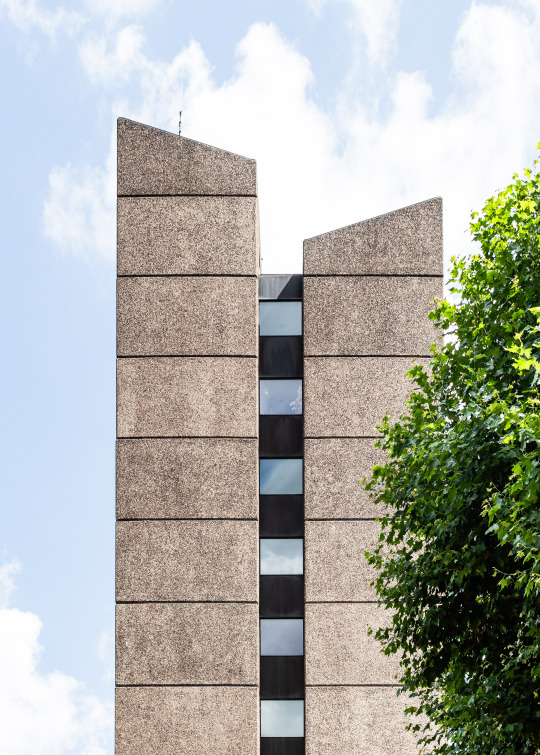
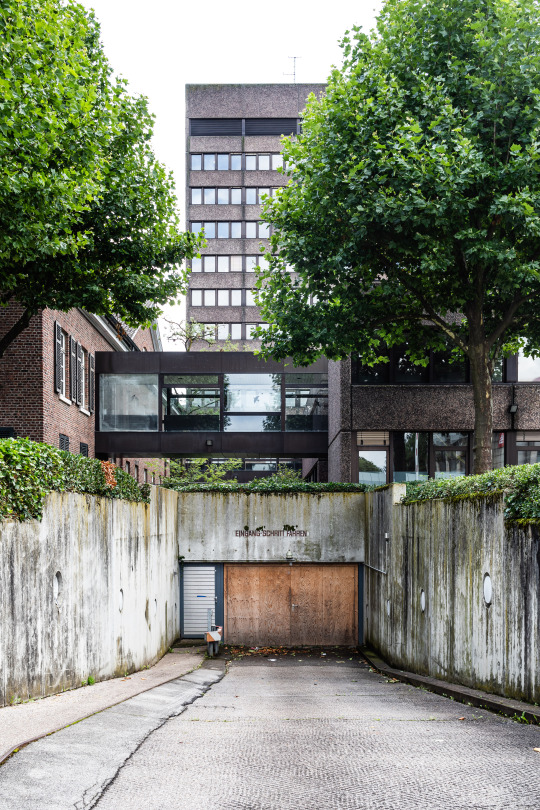

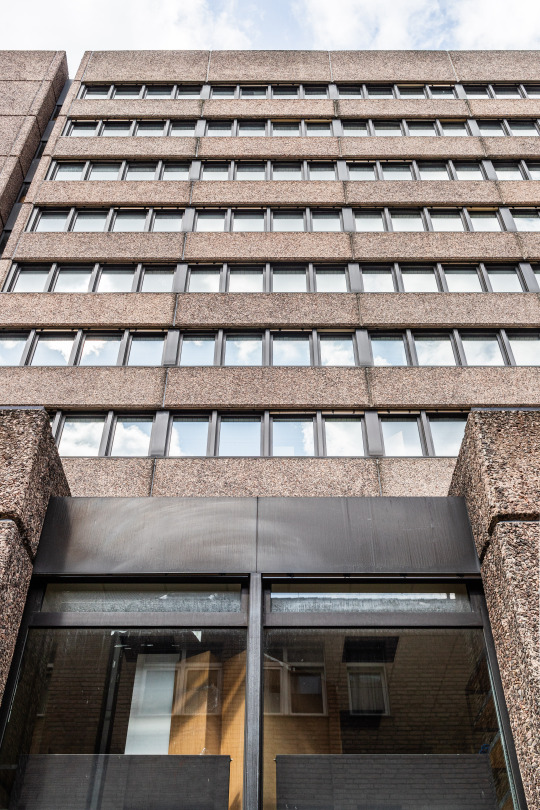

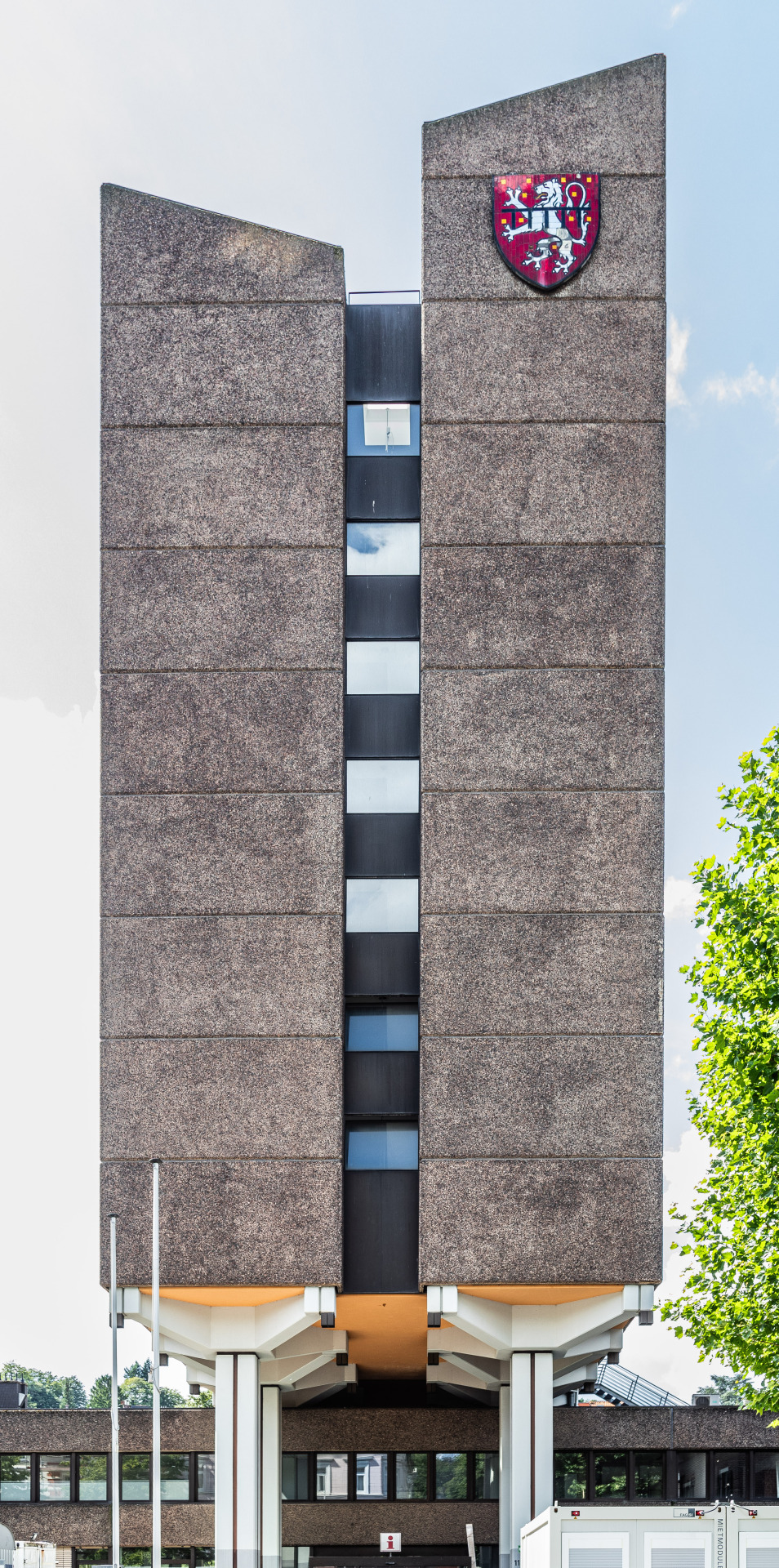

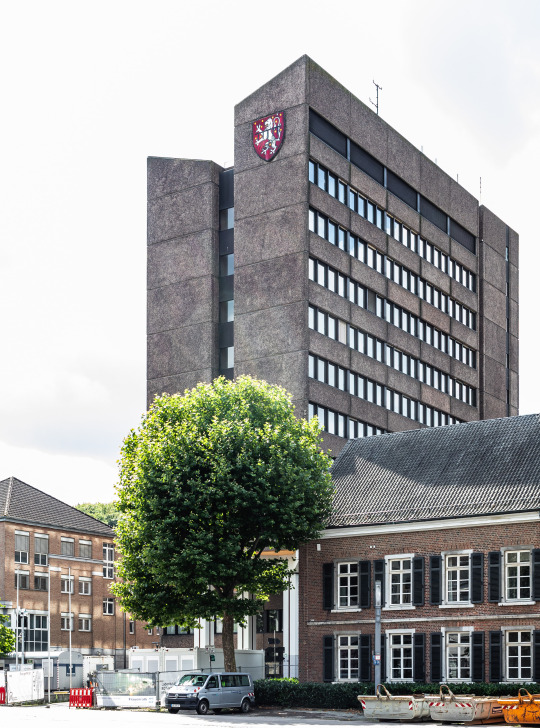
city hall stolberg // stolberg (rhineland)
completion: 1977
stolberg town hall is a prime example of brutalism in the rhineland. a solitary building in the old town whose special feature is the stilts on which the front of the main building rests. unfortunately, the building was damaged during the flood of 2021 and is to be demolished. An unparalleled disappointment.
#architecture#photography#architecture photography#moderne#rhineland#nrw#germany#stolberg#post war modern#post war architecture#nachkriegsmoderne#nachkriegsarchitektur#nachkriegsmoderne rheinland#nachkriegsarchitektur rheinland#nachkriegsmoderne deutschland#nachkriegsarchitektur deutschland#german post war modern#german post war architecture#design#brutalism#brutal architecture
204 notes
·
View notes
Text

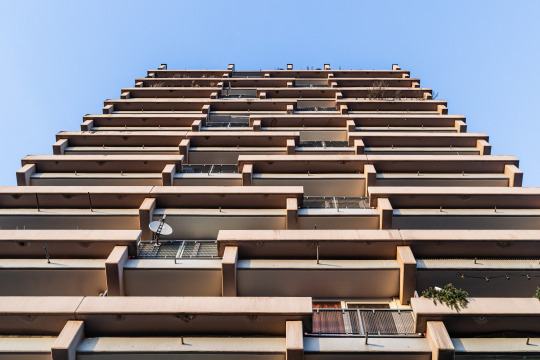
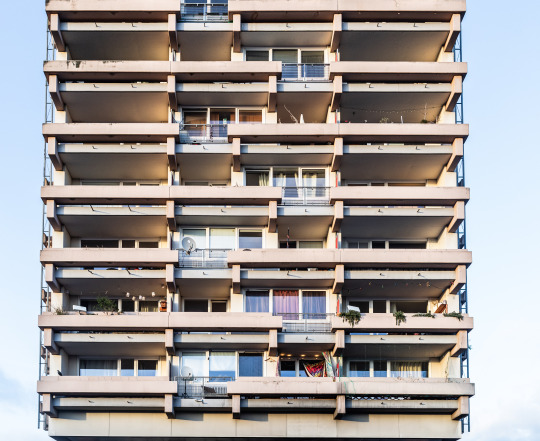
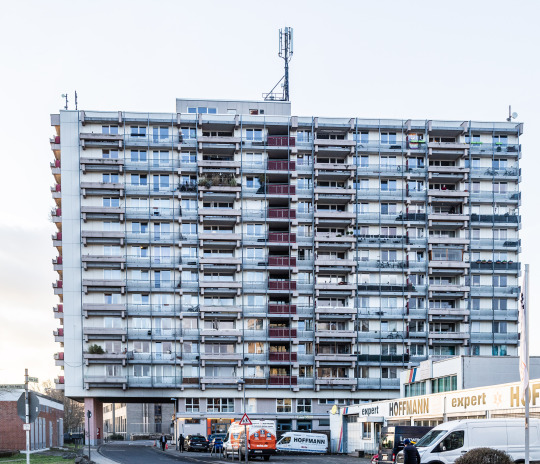
niehler gürtel // köln nippes
the cleverness of the design of this high-rise façade lies in the staggered concrete parapets on the front site. this makes the building stand out very well, also because it functions as a solitaire in this location.
das pfiffige bei der gestaltung dieser hochhausfassade liegt in den versetzt angebrachten betonbrüstungen an der stirnseite. damit kommt das gebäude sehr gut zur geltung, auch weil es als solitär an dieser stelle fungiert.
#photography#architecture#architecture photography#design#high rise#moderne#rhineland#nrw#germany#german post war modern#cologne post war modern#rhineland post war modern#nippes#cologne#köln#german post war architecture#cologne post war architecture#rhineland post war architecture#nachkriegsmoderne#post war architecture#nachkriegsarchitektur#deutsche nachkriegsarchitektur#deutsche nachkriegsmoderne#nachkriegsmoderne köln#Nachkriegsarchitektur köln#nachkriegsmoderne rheinland#nachkriegsarchitektur rheinland
122 notes
·
View notes
Text

severinstraße // köln südstadt
beautiful shop with a beautiful typography, which is still in the same use as it has been for many years.
ein charmanter laden mit einer schönen typografie, der schon seit vielen jahren in der gleichen nutzung ist.
#neonsign#cologne#köln südstadt#storefrontdesign#typography#architecture#urban photography#photography#street photography#nrw#germany#rhineland#post war store design#ladenfronten nachkriegszeit#urban#design
48 notes
·
View notes
Text


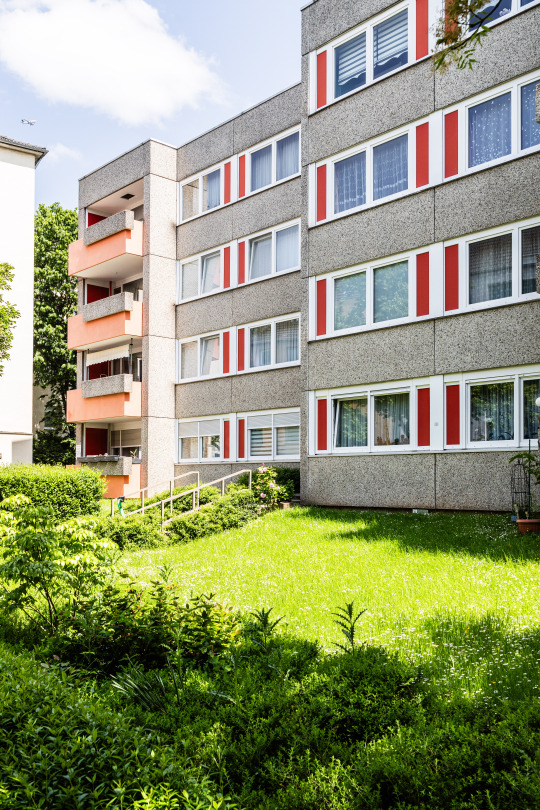
dortmunder & pyrmonter straße // köln buchforst
In the federal states of the old federal republic of germany too, you come across housing estates that were built using the prefabricated slab construction system and that are strikingly similar in style and design to their sisters in the former german democratic republic. if i didn't know that i was in the depths of cologne, one might also think that the pictures were taken in leipzig, dresden, berlin or suhl.
but when i start researching the buildings and types, it seems to me that east german prefabricated housing is much better researched than its west german siblings.
#cologne#köln#buchforst#köln buchforst#architecture#photography#architecture photography#moderne#plattenbau#design#nrw#germany#rhineland#post war modern#nachkriegsmoderne#post war architecture#nachkriegsarchitektur#cologne post war modern#cologne post war architecture#rhineland post war modern#rhineland post war architecture#german post war modern#german post war architecture#deutsche nachkriegsmoderne#kölner nachkriegsmoderne#deutsche nachkriegsarchitektur#kölner nachkriegsarchitektur#nachkriegsmoderne rheinland#nachkriegsarchitektur rheinland
94 notes
·
View notes
Text

venloer straße // köln ehrenfeld
the sun rises on the balconies in ehrenfeld, even on these days when it usually makes itself scarce.
die sonne geht auf, auf den ehrenfelder balkonen, auch an diesen grauen tagen wo sie sich sonst eher rar macht und wir uns nach ihr sehnen.
#cologne#architecture#photography#architecture photography#moderne#köln ehrenfeld#ehrenfeld#design#post war architecture#german post war architecture#tile#rhineland post war architecture#cologne post war architecture#cologne post war modern#rhineland post war modern#nrw#deutsche nachkriegsmoderne#deutsche nachkriegsarchitektur#nachkriegsmoderne köln#nachkriegsarchitektur köln#nachkriegsmoderne rheinland#nachkriegsarchitektur rheinland#tile design
52 notes
·
View notes
Text
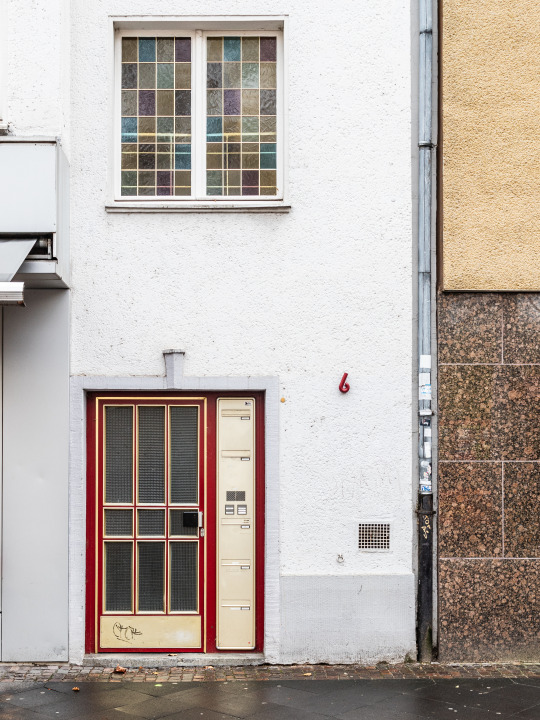
pfeilstraße // köln apostel-viertel
nowadays, entrance doors are usually a much underestimated part of buildings, but this was not always the case. a very good example is this door from the post-war period, which is located in cologne's pfeilstrasse.
eingangstüren sind heutzutage meist ein deutlich unterschätzter bestandteil von gebäuden, dem war aber nicht immer so. früher waren sie durchaus mit der repräsentativste bestandteil der architektur. ein sehr gutes beispiel ist diese tür aus der nachkriegszeit die sich in der kölner pfeilstraße befindet.
#photography#architecture#architecture photography#design#cologne#köln#köln apostelviertel#germany#rhineland#nachkriegsarchitektur#nachkriegsmoderne#post war architecture#post war modern#german post war modern#cologne post war modern#rhineland post war modern#rhineland post war architecture#cologne post war architecture#german post war architecture#deutsche nachkriegsmodern#kölner nachkriegsmodern#nachkriegsmoderne rheinland
68 notes
·
View notes
Text
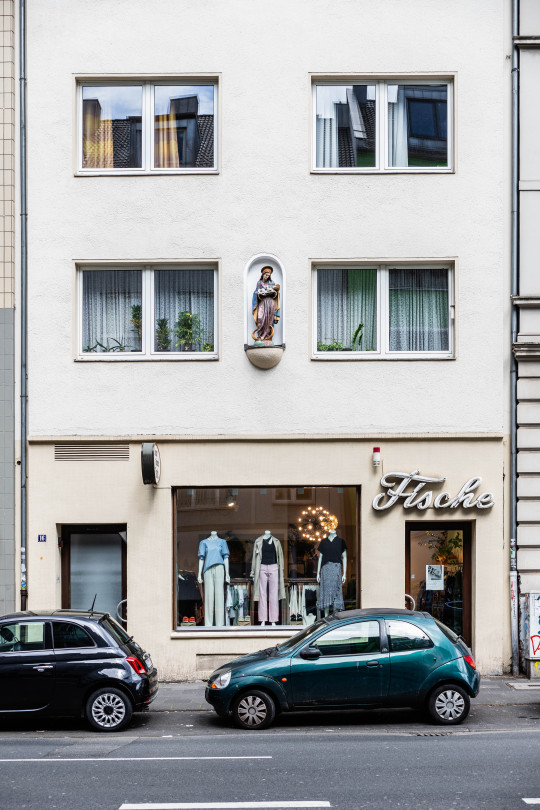
roonstraße // köln kwartier latäng
fish is not always inside where fish is labelled.
nicht immer sind fische da zu finden wo fische draufsteht.
#cologne#köln#neonsign#storefrontdesign#kwartier latäng#photography#architecture#architecture photography#design#nachkriegsmoderne#nachkriegsmoderne köln#nachkriegsmoderne rheinland#nachkriegsmoderne deutschland#germany#post war architecture#nachkriegsarchitektur#cologne post war modern#rhineland post war modern#german post war modern#german post war architecture#rhineland post war architecture#cologne post war architecture#nachkriegsarchitektur köln#nachkriegsarchitektur rheinland#nachkriegsarchitektur deutschland#madonna#madonna and child
20 notes
·
View notes